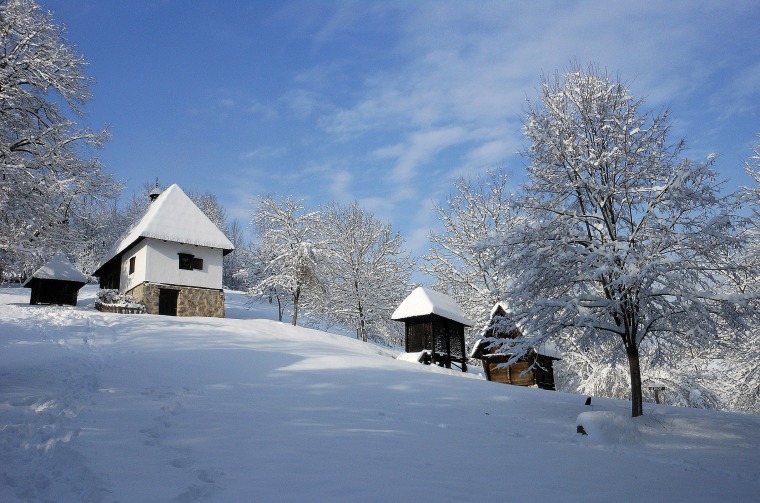Traditional old houses from the 19th century are a part of the “Moravski konaci” ethno village, built on a lake with small islands mutually connected by wooden bridges.
The “Moravski konaci” (eng. Lodgings of Morava) ethno village is surrounded by a lake with nine small islands mutually connected by wooden bridges. It is located near a major highway not far from the town of Velika Plana, less than 100 km from Belgrade.
In a part of the village there is an apartment complex made of renovated 19th century houses, surrounded by beautiful green nature. Another part of the village is used for sport and recreation and consists of a small aqua park (with swimming pools for children and adults and a big water slide) and restaurants. A parking is provided for all visitors.
Eight renovated houses provide the guests of “Moravski konaci” with peace and pleasure, and allow them to get familiar with the hospitality of a Serbian village.
Lodgings are made of authentic old houses brought in from various abandoned Serbian villages. The interior of each house is adjusted to the needs of modern life and is very similar to the one you can find in hotels. On the very lakeside, in the middle of the “Moravski konaci” ethno village, there is a Serbian cuisine restaurant made of wood in the shape of two crosses.
Kind personnel dressed in Serbian folk costumes shall offer you some national dishes in the first place, but also grill, roasted meat and fresh hot homemade bread, and some homemade cheese kajmak (a kind of salty cream). And of course, all kinds of homemade drinks.
Short staircase shall take you from the restaurant to shores of the lake, and on two of its islands there are a cake shop and a coffee shop in which they serve homemade pastry, and coffee is manually ground and roasted so visitors could learn how it was done a long time ago. There are two water mills on the shore of the lake and their sounds complete the atmosphere of the times long gone.
Fishing in the lake is allowed, and visitors can also enjoy some boating. There is fish of high quality in the lake (catfish, carp, pike…) so fishermen have managed to catch some really big ones (5 kilos and more) so far. Inside the village there is a church dedicated to St. Nicholas in which liturgies, weddings and baptisms are regularly held.
For those who desire to walk and have some fresh air all the way around the lake there is a rocky walkway with benches. Organized evenings dedicated to poetry, traditional music, hunting and fishing are held in the “Moravski konaci” ethno village on a regular basis, and one can also enjoy various wine tastings and culinary competitions.
How to get to the “Moravski konaci” ethno village?
“Moravski konaci” can be reached by bus or by your personal transport.
If you decide to come here by car, the fastest way to get there is to take the E-75 highway to Niš when coming from Belgrade. Journey on the highway can be quite pleasant especially since you are only going to Velika Plana – around 100 km from Belgrade. “Moravski konaci” is only 2 km from the center of Velika plana on the regional road to Velika Livadica, and Žabare.
If you decide to go by bus, there are regular bus lines from the Belgrade bus station to Velika Plana.
You can also get to the “Moravski Konaci” ethno village from Smederevo, Smederevska Palanka, Jagodina, Kragujevac and Arandjelovac since it is located at the very crossroads of all the important regional roads.
When you are already here, don’t miss…
Enjoying the benefits of untouched nature and the domestic atmosphere of an ethno village.
Freshly baked cake, homemade cheese and kajmak, grill and other culinary specialties of traditional Serbian cuisine in a restaurant of domestic cuisine which will be waiting for you with a feast.
Be sure to visit the Kiseljak spring of mineral water.
And then a little bit of history – you must visit the villages of Visevac and Radovanjski Lug, the birthplace but also the place of death of the leader of the First Serbian Uprising against the Ottoman empire – Djordje Petrović Karadjordje, and the Pokajnica church from 1818 made of oak wood. A legend says it was built by the order of Serbian prince Miloš Obrenović who sought atonement for ordering the murder of Karadjordje, his own best man.
Photo: www.etnoselo.rs














